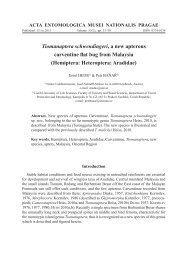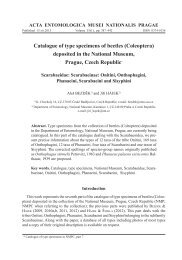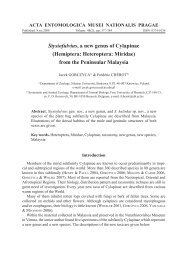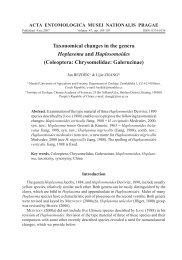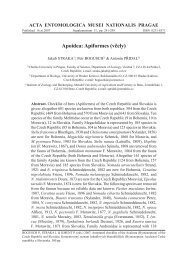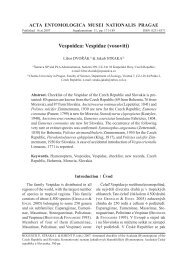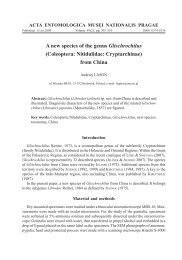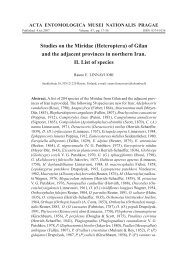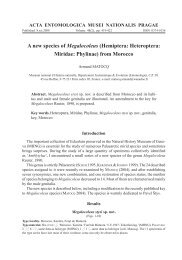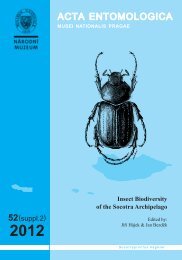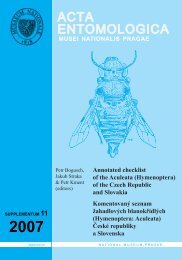Revision of the Palaearctic species of the Coccinella ...
Revision of the Palaearctic species of the Coccinella ...
Revision of the Palaearctic species of the Coccinella ...
You also want an ePaper? Increase the reach of your titles
YUMPU automatically turns print PDFs into web optimized ePapers that Google loves.
Acta Entomologica Musei Nationalis Pragae, 45, 2005 137<br />
Hastate portion rhomboid and dilated at base, passing into narrow, tongue-shaped apex, distinctly<br />
shorter than half <strong>of</strong> hastate portion. Dorsal margin slightly sinuate with apex sharply<br />
pointed, feebly curved ventrally. Paramere thick, finger-shaped, only slightly curved at basal<br />
0.4. Basal piece <strong>of</strong> aedeagus quadrangular, bearing large triangularly acuminate appendix.<br />
Trabes robust, gradually more strongly curved distally, nearly as long as basal piece and<br />
paramere combined. Sipho moderately long. Siphonal capsule robust with inner hook-shaped<br />
projection strong, curved dorsally, dorsal rib well developed, irregularly semicircular. Siphonal<br />
tube moderately slender, in basal third irregularly semicircularly rounded, forming ra<strong>the</strong>r<br />
sharp angle, apex <strong>of</strong> sipho only slightly dilated at <strong>the</strong> base. Preapical supporting sclerites<br />
parallel-sided dorsoventrally and narrowed laterally, bearing two inequal interconnected membranose<br />
swellings at each side, not extremely enlarged. Proximal pair <strong>of</strong> swellings subtriangular,<br />
without free portion, distal one oval, partly free. Terminal ampulla <strong>of</strong> sipho moderate in<br />
size, subtriangular.<br />
Female genitalia. Genital plate (hemiventrite 9) robust, about twice as long as wide, asymmetrically<br />
pear-shaped with ra<strong>the</strong>r thick, strongly curved basal portion. Stylus well developed,<br />
conical, bearing 4 setae. Sperma<strong>the</strong>ca semicircular, nodulus short, much shorter than<br />
ramus, cornu moderately enlarged medially. Infundibulum about as long as sperma<strong>the</strong>ca, with<br />
body cylindrical, equally enlarged at both ends, campaniform distal end ra<strong>the</strong>r short.<br />
Length. Males (n = 3) 4.87-5.28 mm; females (n = 3) 5.13-5.35 mm. KAPUR (1973) gives<br />
5.4 mm.<br />
Variability. Black spots on elytra discrete (Fig. 83) or gradually confluent in a pattern <strong>of</strong><br />
½+S, 1+2+3 and 4+5 (Fig. 84) or <strong>of</strong> 1+2+3+S+½+S+3+2+1 (Fig. 85) to form a tricuspidate<br />
or anchor-like pattern in anterior half <strong>of</strong> elytra. Spots on posterior half <strong>of</strong> elytra invariably<br />
confluent.<br />
Distribution. Known material <strong>of</strong> C. marussii is extremely limited, coming only from <strong>the</strong><br />
mountainous parts <strong>of</strong> nor<strong>the</strong>rnmost Pakistan and Kashmir.<br />
Discussion. The <strong>species</strong> has been known only from <strong>the</strong> female holotype deposited in Museo<br />
Civico di Storia Naturale, Trieste, Italy. Although I have not studied <strong>the</strong> type, <strong>the</strong> identity <strong>of</strong><br />
<strong>the</strong> examined material is doubtless given <strong>the</strong> locality. It is a characteristically coloured <strong>species</strong><br />
with <strong>the</strong> tips <strong>of</strong> hind femora visible from above, and related to C. magnopunctata Rybakow,<br />
1889, in having similar siphonal structures. The hastate portion <strong>of</strong> median lobe, however,<br />
much resembles that <strong>of</strong> C. transversoguttata. FÜRSCH (1981) also recorded C. marussii<br />
from Turkey but <strong>the</strong> material belongs to ano<strong>the</strong>r, undescribed <strong>species</strong>; this new <strong>species</strong> is<br />
described below.<br />
<strong>Coccinella</strong> (<strong>Coccinella</strong>) hodeki sp. nov.<br />
(Figs. 21-33, 77, 86)<br />
<strong>Coccinella</strong> marussii: FÜRSCH (1981): 81 (misidentification).<br />
Type material. HOLOTYPE, : TURKEY: ERZURUM province, 15 km SW Erzurum, Palandöken<br />
Dağları [Mts.], Tekederesi village env., 39°48.8´N, 041°09.0´E – 39°47.6´N, 041°09.7´E,<br />
steppes and pasture near spring, tunnels <strong>of</strong> gopher, 1965-2230 m a.s.l., 26.-28.vi.2004, J.<br />
Hájek & J. Růžička lgt. Antenna, abdomen, male genitalia and tarsal claw <strong>of</strong> hind leg dissected.



